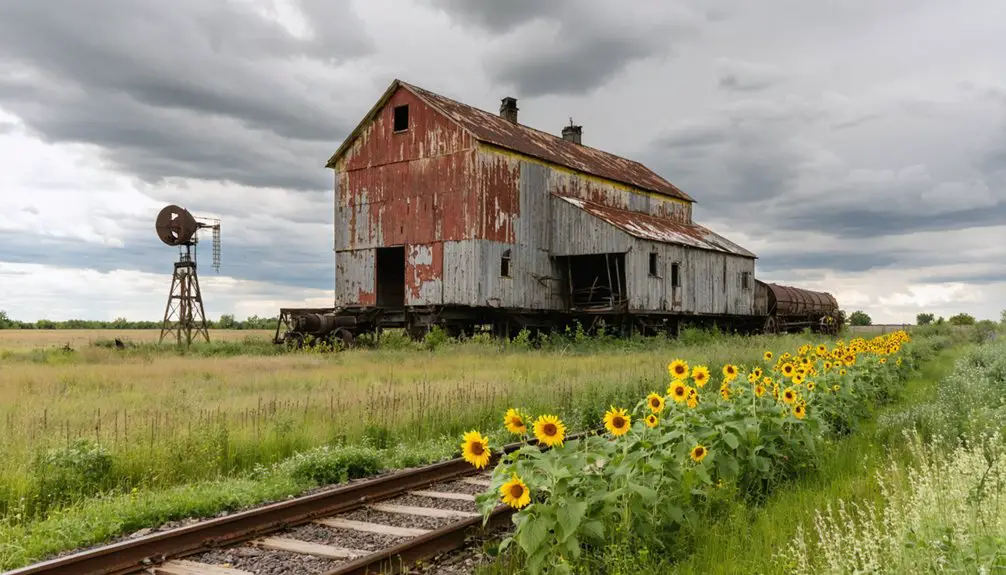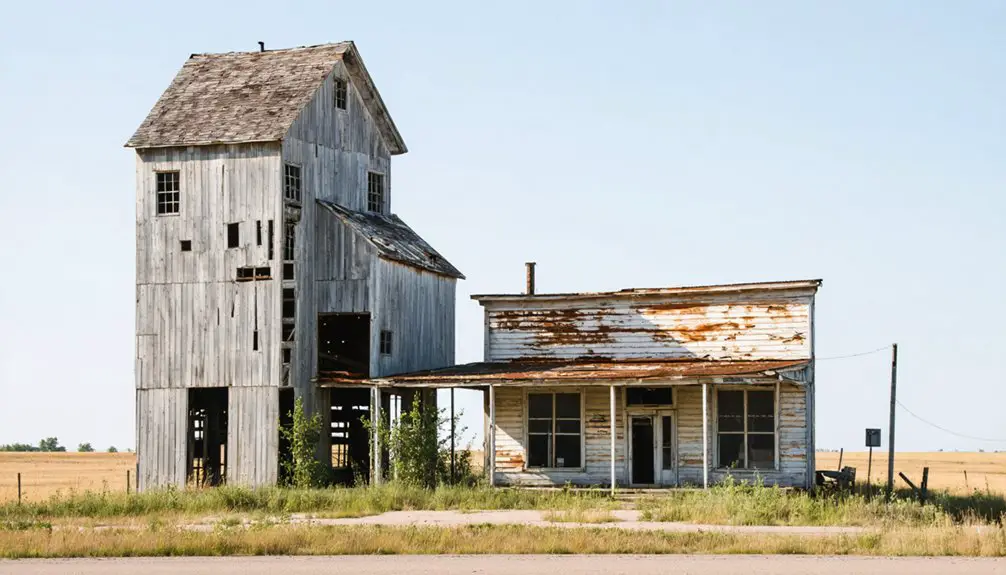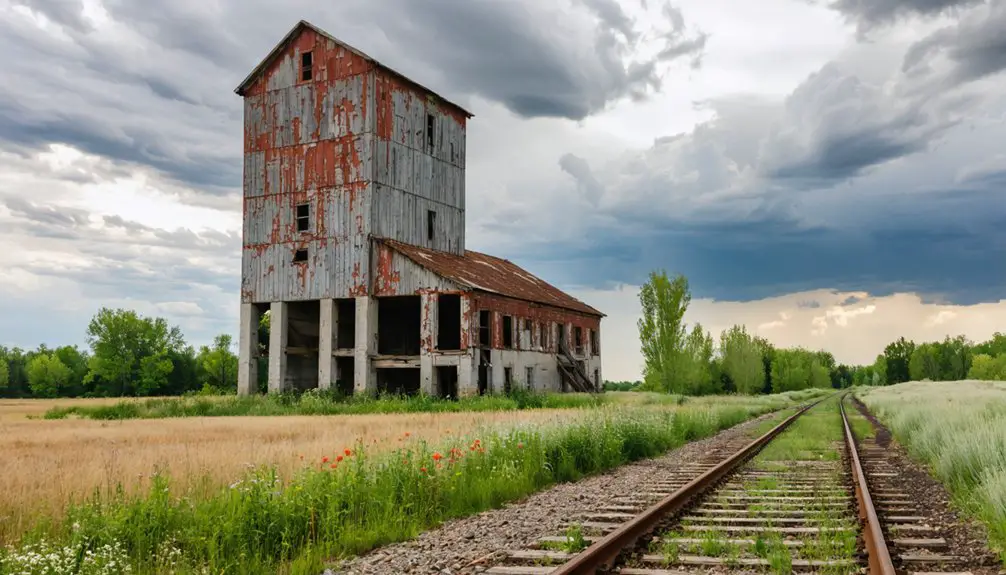You’ll find Shell City’s remains along Minnesota’s Shell River, where this once-promising frontier settlement emerged from a fur trading post in 1874. The town thrived on steamboat trade, stagecoach routes, and a bustling pearl button industry until the 1890s, when the Northern Railroad’s decision to bypass the settlement sealed its fate. Today, you can explore the old cemetery and homestead remnants that tell the story of this fascinating ghost town‘s rise and fall.
Key Takeaways
- Shell City was a frontier settlement established in 1880 with a post office founded by William E. Kindred in Minnesota.
- The town served as an economic hub with steamboat connections to Mississippi River markets before its decline.
- Railroad expansion bypassed Shell City in 1890, leading to merchants relocating to rail-served locations.
- The closure of the post office in 1901 marked Shell City’s final transformation into a ghost town.
- Today, Shell City’s legacy remains through its cemetery, campground, and historic remnants in Shell River Township.
The Birth of a Prairie Settlement
While the Sioux tribes originally called Shell Prairie home, the region’s transformation into a European-American settlement began in the late 1800s through the pioneering efforts of fur traders and early settlers.
You’d find traders like Howitt and AJ Broadfoot establishing posts around 1874, spreading word of the area’s untapped potential. The fertile grasslands, spanning nearly 60 square miles, drew hopeful pioneers seeking freedom on the open prairie. Similar to Park Rapids’ development, the area became a key hub for timber cruisers and trappers.
Following old Native American trails northward, settlers like William E. Kindred ventured into this promising expanse, ready to transform the treeless prairie into productive farmland. Kindred’s initiative led to establishing the area’s initial post office in 1880.
Despite the challenges of prairie agriculture and isolation, these determined pioneers established farms and built the foundations of a new community, driven by dreams of prosperity in Minnesota’s northern frontier.
Life Along the Shell River
Along the winding Shell River, early settlers found an ecosystem teeming with life and resources that would shape their community’s destiny. The area’s rich heritage dates back to the Dakota and Anishinaabe peoples who first inhabited these lands.
You’ll find remnants of their industrious spirit in the river ecology, where abundant mussel and clam shells once fueled a thriving button factory. William Morrison established an early trading post here in October 1802, setting the foundation for future settlement. As you navigate the river’s course through the Northern Lakes and Forests, you’re tracing the same waters that sustained fishing, trade, and transportation for both Indigenous peoples and pioneers.
The river’s powerful 250-cubic-foot-per-second flow carves through three counties, connecting Shell Lake to the mighty Mississippi.
Today, historical artifacts like the Shell City cemetery and abandoned settlement sites tell stories of determined settlers who built their lives around this essential waterway, while modern visitors enjoy the same pristine wilderness for recreation.
Economic Hub and Trading Routes
Before Shell City’s eventual decline, the bustling settlement served as an important economic hub where river navigation and overland routes converged in west-central Minnesota.
The Shell City Navigation Company‘s steamboats connected local merchants to Mississippi River markets, while the Wheat Trail facilitated transport of agricultural goods to Verndale. Similar to how trading posts served as critical commercial centers in Minnesota’s early fur trade era, Shell City became a vital junction for merchants and farmers. Like the Marketplace of the Central Plains, Shell City established itself as a crucial trading destination for the surrounding region.
These trade dynamics created a thriving nexus of commerce that shaped the region’s early development.
- You’d find steamboats and barges moving timber and crops along the Shell and Crow Wing rivers.
- The Wheat Trail stretched 30 miles to Verndale, where ox teams hauled precious grain.
- River navigation made Shell City a significant collection point for distributing goods throughout the region.
- Local farmers relied on both water and land routes to reach broader markets downstream.
The Button Factory Legacy
Along the Mississippi River in Shell City, you’d find clam harvesters using specialized rakes and boats to gather the prized freshwater mussels that fueled the bustling button industry.
You could watch skilled workers transform these shells through a precise manufacturing process – cutting, grinding, and polishing the iridescent material into fashionable buttons that adorned clothing across America. The Lake Pepin Pearl Button Company processed thousands of shells into button blanks that were shipped to Iowa facilities.
Dragging hooks were essential tools used by clammers to collect mussels from the riverbed. While the industry thrived in the early 1900s, the combination of overharvested mussel beds and the rise of plastic buttons eventually led to Shell City’s economic decline and ultimate abandonment.
River Clam Harvesting Operations
During the late 19th and early 20th centuries, three major river clam harvesting operations transformed Shell City’s economy and landscape.
You’d find workers wading into the Mississippi River and Lake Pepin’s waters, carefully selecting thick-shelled mussels for the booming button industry. While pearl hunting offered dreams of quick riches, it’s the systematic harvesting for button manufacturing that truly shaped the region’s destiny. Many workers used long sticks with hooks to reach clams in deeper waters. The Lake City area eventually produced half the world’s buttons from these harvested shells.
- Harvesters would collect over 21,000 tons of shells annually at the industry’s peak.
- Local families like the Samuelsons built their livelihoods around clam harvesting.
- Shell processing facilities, like Lake Pepin Pearl Button Company, transformed raw materials into valuable commodities.
- Early clam conservation efforts emerged as sustainable harvesting became essential for industry survival.
Sadly, by the 1920s, overharvesting had devastated local mussel populations, marking the beginning of the industry’s decline.
Button Manufacturing Process
The intricate process of pearl button manufacturing transformed raw mussel shells into gleaming fashion necessities through a sequence of specialized steps.
After shell harvesting from rivers like the Mississippi, workers would boil and clean the mussels, then soak them to prepare for cutting. You’d find skilled craftsmen operating foot-powered lathes in early factories, carefully cutting round “blanks” from the iridescent mother-of-pearl layers.
As button production evolved, steam-powered machinery and the revolutionary “Double Automatic” machine streamlined operations, making pearl buttons affordable for everyday households.
Workers would grind and polish each button to perfection before sewing them onto cards for distribution. At its peak, factories like the one in Muscatine churned out over 1.5 billion buttons annually, until plastic alternatives and depleted mussel beds changed the industry forever.
Economic Impact and Decline
While Shell City’s button industry once drove remarkable economic prosperity, its eventual decline mirrored the fate of similar factories dotting the Mississippi River.
You would’ve seen thousands of workers, from shell gatherers to skilled button cutters, earning good wages during the industry’s peak. But nature’s limits and changing markets spelled doom for this once-thriving enterprise.
- Overharvesting of freshwater mussels depleted essential raw materials, making production unsustainable
- The rise of cheaper plastic buttons drastically reduced demand for pearl buttons
- Factory closures led to widespread job losses, triggering regional economic decline
- Competition from synthetic materials and dwindling resources forced many businesses to shutter
Today, you’ll find only memories and museum pieces where this bustling industry once stood, reminding us how quickly fortunes can change when natural resources run dry.
Daily Life in a Frontier Town
Life in Shell City revolved around the rhythms of frontier existence, where wooden frame homes clustered near the post office and hotel formed the heart of this prairie settlement.
You’d find yourself participating in community gatherings at the school, church services, or the bustling stagecoach barn, where news and supplies arrived regularly from Verndale.
Your survival strategies would have centered on maximizing the area’s natural abundance. You’d farm the fertile Shell Prairies, hunt in nearby woods, and perhaps work at the button factory harvesting river clams.
Living off the land’s bounty meant cultivating prairie soil, tracking woodland game, and collecting river clams for the local button industry.
During harsh winters, you’d rely on stored provisions and the warmth of your wooden home. The continental climate demanded resilience, while the isolated setting meant you’d forge strong bonds with neighbors, sharing resources and supporting each other through the challenges of frontier life.
Transportation and Trade Networks

If you’d visited Shell City in its heyday, you would’ve found a settlement largely dependent on rudimentary stagecoach routes connecting it to other frontier towns across Wadena County.
These horse-drawn transport services, while essential for mail and passenger movement, couldn’t match the economic advantages that railroad connections brought to competing settlements in central Minnesota.
Shell City’s inability to secure railroad access ultimately contributed to its decline, as neighboring towns with rail lines drew away trade and settlers during the late 19th century.
Stagecoach Routes and Services
Before railroads transformed Minnesota’s transportation landscape, stagecoach routes served as the lifeline connecting southeastern settlements like Winona, St. Peter, and Rochester.
In the Shell City area, you’d find stage lines operating by the 1880s, crossing the Shell River along paths like the historic Wheat Trail. These routes preserved crucial cultural heritage while fostering regional development.
- Drivers navigated paths following natural landmarks and river crossings
- Stops provided essential services including lodging, meals, and horse stables
- Stage lines transported mail, passengers, and goods between rural communities
- Winter travel often switched to sleigh transport for crossing frozen waterways
The routes integrated Shell City into broader trade networks, helping open interior Minnesota lands to commerce and settlement while establishing enduring travel corridors still visible today.
Railroad Development Impact
While stagecoaches carved out essential routes through Minnesota’s wilderness, the arrival of the Northern Railroad in 1890 redrew the region’s transportation map – and sealed Shell City’s fate.
You’ll find the railroad expansion consequences were swift and devastating for the once-thriving river town. The new line bypassed Shell City completely, instead running from Eagle Bend to Park Rapids through Sebeka and Menahga.
As rail transport revolutionized regional commerce, Shell City’s ghost town transformation began.
You’d have witnessed merchants and traders abandoning the old Wheat Trail that connected Shell City to Verndale, choosing instead rail-served locations for their businesses.
The town’s economic lifeblood – river transport and local trade networks – couldn’t compete with the railroad’s superior speed and reliability in moving goods and people.
The Railroad Decision That Changed Everything
Although Shell Prairie boasted rich agricultural potential in the late 1800s, a fateful decision by railroad companies to bypass the area would seal Shell City’s ultimate fate.
Despite fertile farmland and high hopes, Shell City’s destiny was sealed when railroad companies chose to lay their tracks elsewhere.
You’ll find this critical railroad decision reflected a broader pattern where major companies like Northern Pacific prioritized more profitable routes, leaving smaller agricultural communities to wither.
- You’d to haul your crops by wagon to distant rail lines, facing higher transportation costs that cut into your farm’s profits.
- While the Twin Cities and Iron Range flourished with direct rail service, Shell City’s isolation grew.
- You watched as neighboring towns with railroad access prospered, drawing away business and residents.
- Your community’s dreams of economic growth faded as the major rail companies established their networks elsewhere, marking Shell City for eventual ghost town status.
From Bustling Town to Abandoned Site

When you explore Shell City’s decline from the 1880s through the early 1900s, you’ll discover a sobering pattern of population loss and abandonment that transformed a once-promising settlement into a ghost town.
The community’s steady exodus became painfully apparent through shuttered businesses, dismantled buildings, and a dwindling number of residents who sought opportunities elsewhere.
Railroad’s Fatal Impact
The Great Northern Railroad‘s fateful decision to bypass Shell City by seven miles to the west sealed the town’s eventual demise.
Without direct rail access, you would’ve seen the town’s transportation alternatives – river steamboats, stagecoaches, and wagon trains – struggle against the rising tide of rail commerce.
Despite efforts to maintain economic resilience, Shell City couldn’t compete with rail-connected neighbors.
- Shell River’s button factory lost its competitive edge due to costly freight alternatives
- Local wheat farmers faced grueling 40-mile wagon hauls to Verndale’s railhead
- Businesses and residents relocated to towns with direct rail service
- Steamboat and stagecoach routes proved inadequate against rail’s speed and efficiency
The town’s isolation from the expanding rail network ultimately stripped away its commercial significance, leading to the closure of essential services and mass exodus of its population.
Population Exodus Timeline
From Shell City’s hopeful beginnings in 1879 under William E. Kindred, you’d have witnessed dramatic shifts in population demographics over two decades.
The town’s initial growth attracted settlers with its fertile lands and promise as a regional hub, supporting a modest but stable community through the 1880s.
Migration patterns took a decisive turn in the 1890s when the Great Northern Railroad bypassed Shell City by seven miles.
You’d have seen the gradual exodus as residents relocated closer to the rail lines, and businesses shuttered one by one.
The post office’s closure in 1901 marked the final turning point, accelerating the town’s abandonment.
Preserving Shell City’s Memory
Through dedicated preservation efforts, Shell City’s memory lives on despite its physical structures having largely disappeared from the Minnesota landscape.
You’ll find historical storytelling and community engagement thriving through digitized archives, oral histories, and collaborative preservation projects between local historians and heritage societies.
You can explore Shell City’s legacy through:
- Cemetery grounds and campgrounds that carry the town’s name
- Digital archives containing land records and photographs from the 1879-1901 era
- Regional heritage events featuring artifacts and historical exhibits
- Documentaries and online platforms sharing stories of early settlers
Today’s preservation work guarantees that future generations will understand Shell City’s role in Wadena County’s development, from its founding as Kindred to its eventual decline after the post office closure in 1901.
Walking Through History Today

Walking Shell City’s historic grounds today offers visitors a unique window into Minnesota’s pioneering past, even as sparse physical remnants mark where this once-hopeful settlement stood.
You’ll find key landmarks that preserve the town’s historical significance, including the Shell City cemetery, campground, and horse camp.
As you explore section 2 of Shell River Township, you can trace the community’s brief timeline from its 1879 founding as Kindred post office until its decline in 1901. The surrounding Shell Prairies echo the landscape early settlers encountered, while interpretive materials and local guides help you understand the town’s unfulfilled destiny.
Whether you’re following marked trails or discovering old homestead remnants, you’ll experience firsthand the challenging conditions that shaped this frontier community’s fate.
Frequently Asked Questions
How Many Native American Artifacts Have Been Found at the Shell City Site?
You won’t find specific artifact quantities at Shell City itself, as archaeological discoveries there haven’t yielded confirmed Native American artifacts during Minnesota Historic Society’s shovel test surveys, though nearby sites show significant findings.
What Was the Peak Population of Shell City During Its Heyday?
While the exact peak is lost to time, you’d find historical significance points to modest growth, with best estimates suggesting fewer than 200 souls called this frontier settlement home during its heyday.
Were There Any Notable Crimes or Lawlessness in Shell City?
You won’t find documented crime statistics or law enforcement incidents in the records. The town’s short-lived existence was remarkably peaceful, with no notable cases of lawlessness or criminal activity recorded.
Did Any Famous Historical Figures Ever Visit or Stay in Shell City?
You won’t find any famous visitors of historical significance in town records. While William E. Kindred, Francis Yoder, and Sewall Chandler founded the settlement, no nationally recognized figures ever graced Shell City.
What Happened to the Residents After Shell City Was Abandoned?
You’ll find most residents’ fate led them to nearby Wadena County towns, seeking better opportunities and services. Ghost town stories suggest they gradually dispersed after the post office closed in 1901.
References
- https://en.wikipedia.org/wiki/Shell_City
- https://kids.kiddle.co/Shell_City
- https://www.wikiwand.com/en/articles/Shell_City
- https://lptv.org/local-show/minnesota-shell-prairies/
- https://www.ghosttowns.com/states/mn/shellcity.html
- https://www.youtube.com/watch?v=H6pwKoAZSoM
- http://files.usgwarchives.net/mn/hubbard/history/news1884.txt
- https://www.friendlyrider.com/DocumentCenter/View/4078/Wadena-County-History
- https://www.parkrapidsdowntown.com/history
- http://becker.mngenweb.net/pioneerhistory/ch16.htm



